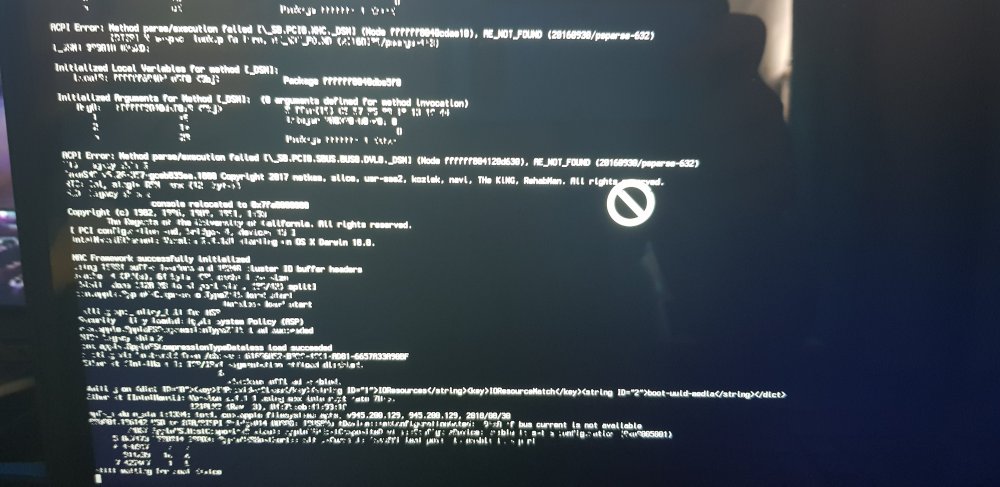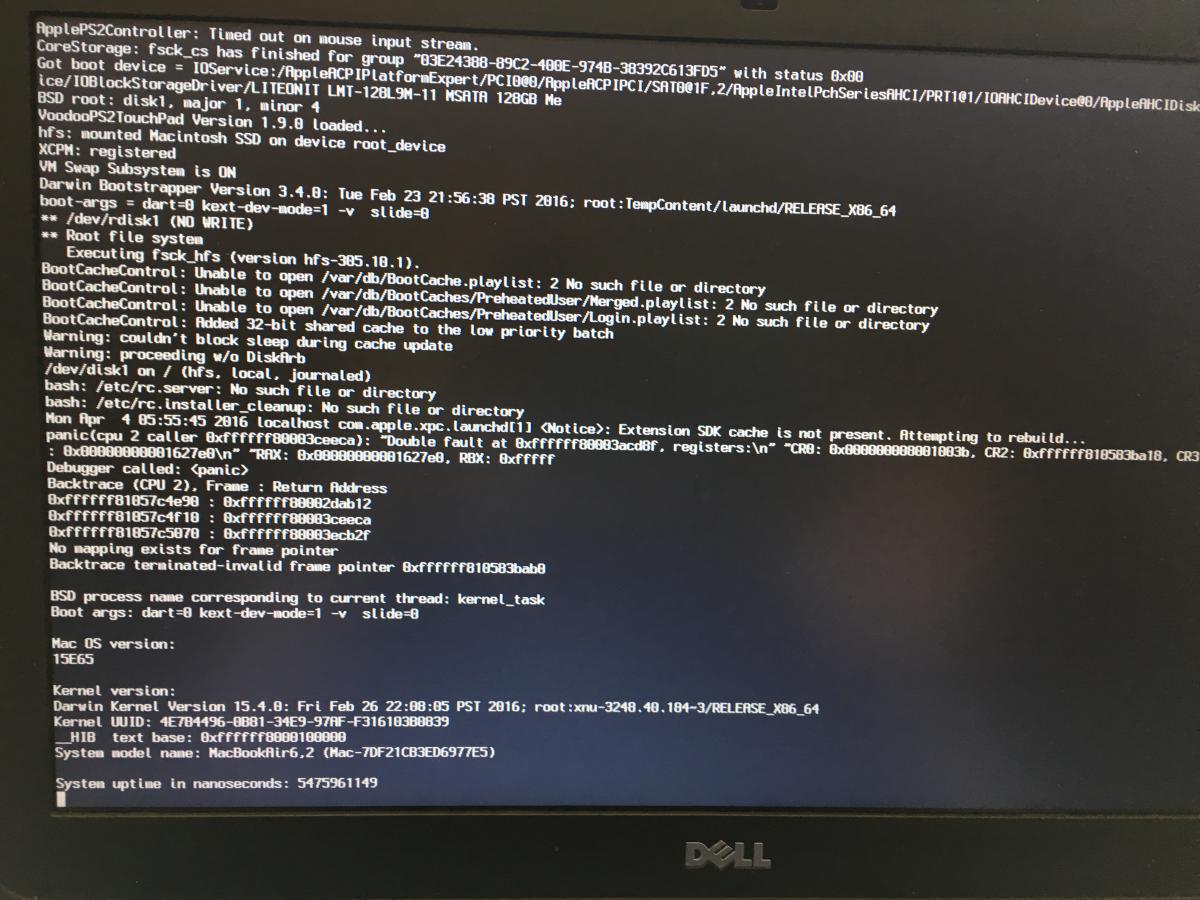Search the Community
Showing results for tags 'boot'.
-
Hi everyone I have problem with catalina installation on my dell precision 3510. Some people told me I need ssdt?? Is anyone who can help me with this?
-
Hi I need help with this urgent. here are my specs: Intel core i7 5600u 16gb ram ddr3 Intel HD Graphics 5500 (Dell) 2047MB NVIDIA GeForce 840M (Dell) Laptop model: Dell latitude e5550
-
[SOLVED] E7240 10.11.4 fresh install boot problem - kernel panic
sales posted a topic in The Archive
I followed the Dell Latitude El Capitan Clover Guide (fresh install of 10.11.4 with E7440 spec) - right after step 13 of Install OS X El Capitan, I got kernel panic and the syetem reboots. Screen shot attached. I have tried reinstalling three times just in case I missed some important step (and subsequently update my BIOS from A12 to A17). But I got the same kernel panic every time. My system spec: Latitude E7240, BIOS A17 i7-4600u 2.1GHz 8GB DDR3L Intel HD 4400, 1366x768 (non-touch) Intel AC7260+BT I tried using cpus=1 at the first installation, and it went on to complete the installation. But I had no sound (no output device), and the mouse pointer stopped responding to the touchpad, And I got a virtual drive mounted (seemed to be the mirror image) instead of the physical internal SSD. It feels like I am opening up another can of worms. So I abandoned that route. How can I fix this??? Update: Incorporating the fixes in 1 & 2 into bootpak solved the kp issue. Fresh installation was a straight through. Now running 10.11.4 on E7240. Some tweaks: powerd failure https://osxlatitude.com/index.php?/topic/8922-solved-e7240-10114-fresh-install-boot-problem-kernel-panic/?p=59260 Cheers- 10 replies
-
Got Yosemite installed with everything working on my E5420. Swapped wifi for a DW1510 and used an E5x20 bootpack I found on the forum here. The system boots fine using Clover from my install USB, but not from the hard drive. I have copied the EFI folder from the USB to the FAT32 formatted ESP on my hard drive. Went into BIOS (version A14), switched boot mode to UEFI, and added boot entry for Cloverx64.efi. upon reboot, the laptop boots into Clover just fine, even using the theme i selected, but no bootable partitions are detected. I have Hfsplus.efi in the drivers64UEFI folder, and the whole EFI/Clover folder structure is identical to the one on my USB, which works. Any ideas what could be causing this issue?
-
Hello all! After some time enjoying my hackintosh I decided to update it to 10.10.4. The update process was successful but after restart the computer some issues appeared. First, I can't start the operating system without the -v -f flags. If I don't enter these options, after a while the boot process gets stuck. Second, sleeping is not possible now. I really miss this, because I used my hackintosh to work and turn it on and off all the time is really time consuming. Any idea about what is going on? My E5420 is an i3 machine, with 4 GB RAM. Currently the SD reader works partially (or randomly) and I haven't tested the expresscard port. The wifi will be replaced as soon as arrives from ebay.
-
Hi, Wondering if anyone has a Dell Latitude D420 bootpack for Snow Leopard 10.6.3 around, I'm struggling to find one. Many thanks.
-
Hi all, If anyone has any tips on this, I'd be very happy to hear them. I'm trying to install Mavericks on a Dell Latitude E6530 (i5-3320M). I have created a USB installer using myhack. When I start up the PC, after the Dell logo, I get a black screen with the white text message "No bootable devices". I have plugged the USB installer into a Dell Latitude E6320 and the installer loads, so it seems the USB drive and the installer are OK. If you have any guidance, please do let me know. Thanks very much, John System Model: Latitude E6530 System Type: x64-based PC Processor: Intel® Core i5-3320M CPU @ 2.60GHz, 2601 Mhz, 2 Core(s), 4 Logical Processor(s) Processor ID: 306a9 Intel HD graphics 4000 BIOS Version/Date: Dell Inc. A09, 13/12/2012 SMBIOS Version: 2.7 Installed Physical Memory (RAM): 4.00 GB Bios boot sequence: USB Storage Device (all other options are disabled) Boot list option: Legacy Advance boot options: enable legacy Option ROMS: enabled Integrated NIC: Enbabled w/PXE is selected SATA operation: AHCI is selected USB configuration: Enable boot support is selected. Enable external usp port is selected Video: the only options are for LCD brightness Security: no passwords are enabled Secure boot: disabled Performance: C-states control: C states is enabled. Performance: Hyperthread control is enabled
-
Hello, I've created a Yosemite installation USB using Uni-Beast (f*ck sensored words). I'm booting the installation using the following flags: USBBusFix=Yes GraphicsEnabler=No -v -f It boots, but before the GUI should start, I'm getting a black screen. The USB stops loading screen, I've been waiting for about 10 minutes. Unfortunately I can't show you any errors because the black screen is just "showing" too fast. Could anyone help me with this? Thank you!
-
Hi, I've tried to install Mavericks on my system, but unfortunately I don't even make it to the installation screen. Bios is set up properly and I've got an intel processor, nvidia graphics and an Asus mainboard. When booting verbose it gets stuck with the following error: USBMSC Identifier (non unique): 058F63646476 0x58f 0x6364 0x100, 2 Still waiting for root device What could that be? Does anybody know a solution? Thanks in advance! Intel Core i3-3240 @ 3,4 Ghz 8 GBs of RAM nVidia GeForce GTX 650 Asus B75M-A
- 6 replies
-
- Installation
- Boot
-
(and 2 more)
Tagged with:
-
First post, long time wannabe hackintosher. Recently I've picked up a Samsung NP900X4D-A03CA laptop, which looks promisingly similar to the NP900X4C/X3C models. i5-3317U and similar (if not same?) BIOS's. First, I'd like to take time in advance to thank anyone willing to lend a hand Second, I've done a hackintosh install before using Hazard's Intel/AMD SSE2/3 distrobution, and although it wasn't pretty, I managed to hack away at it until it was fully functioning on an AMD Athlon II X2 240 processor. Fun times. Third, I'm definitely willing to provide logs, DSDT's, SSDT's, etc, etc. with a little guidance. No, there's not a working anything installation as I'm trying to make this soley an OSX machine, but I can definitely hop into a bootable Linux distribution of anyone's choosing should it assist us in pulling DSDT's or other ACPI data from the mobo. So, without further ado, here's the specs: Problem I've having is getting it to boot without the black screen Intel HD4000 problem. Here's what I've tried so far: Originally I started with Niresh's 10.9.2 customized ISO meant for both Intel and AMD systems, and it worked OK for the installation part. No boot flags required immediately from the get go, just pop the DVD into my external USB DVD Drive, USB 2 or 3 port works fine, boot up, install with default options. The problem is upon reboot, it hangs unless I use the GraphicsEnabler=No flag, and then it doesn't hang, but gets stuck at a black screen, probably trying to display over the micro-HDMI port. (I have ordered a micro-HDMI to HDMI adapter to help troubleshoot this.) I went back at least 8 times, selecting different SMBIOS.plist files, none of which helped in any way, and eventually booted into single user mode -s and was able to run their grafix backup all script to clean all the Intel kext files out. After that, I managed to get it to boot and login, although I had to do so as root because it skipped the initial setup screen...? Anywho, since then I attempted to use EDP, which failed because of other kexts already loaded from Niresh's, so I figured as I have a half-baked install, why not use it to download legit Mavericks and run myHack? Plug in USB for formatting, kernel panic! Needless to say, I ended up creating a myHack USB Installer at work on their Mac's, and used the NP900X4C compatibility pack from OSXLatitude, including your handy guide. Problem there is the installer would also boot to a black screen unless I used -x safe mode flag. (Yes, I did try the GraphicsEnabler=No/Yes and the IGPEnabler=No/Yes flags just for the giggles, neither of which helped.) I went ahead and installed it from -x safe mode flag boot, and selected the "/Extra" Kexts folder bootpack for the NP900X4C but upon reboot, it would start up, seem normal in verbose mode (no abnormal errors) until Mr. DSMOS arrives which is when it finishes booting and bingo bango! Black Screen. I have also tried the IGPlatformId=xxxxxxxx and IGPEnabler=Yes flags, they're not seeming to do anything different. I seem to be in the same pickle as this guy's thread and would love any assistance or insight's into my sillyness. According to the information @Stanislav was able to provide, the Samsung 900X3C/900X3D/900X4C/900X4D models all share the same motherboard, so technically speaking they should all be able to use the same bookpack or DSDT files, yes? (assuming the processors are all i5-3317U's as well) Anywho, I'll await patiently and see if we get anywhere, and do have Mac's at work I can use to keep making hackintosh installation USB's. Many thanks, Erik
-
Hello there. I followed the guide to installing Mac OS X Lion on Dell Latitude D630 and right after loading everything from the Chameleon bootloader, I see a black screen with white writing on it showing a kernal panic: BCM5722D (setupDriver:920): MSI index on 1 panic(cpu 1 caller 0x2ccb0f): Kernal trap at 0x3624703a, type 14=page fault, registers: CR0: 0x8001003b, CR2: 0x00000000, CR3: 0x00100000, CR4: 0x00000660 EAX: 0x00000000, EBX: 0x0000085a, ECX: 0x00000000, EDX: 0x299cdffc CR2: 0x00000000, EBP: 0x2ff6bc58, ESI: 0x05eba800, EDI: 0x00000000 EFL: 0x00010246, EIP: 0x3624703a, CS: 0x00000008, DS: 0x00000010 Error code: 0x00000000 Debugger called: <panic> Backtrace (CPU 1), Frame : Return Address (4 potential args on stack) 0x2ff6ba98 : 0x22032e (0x6abf4c 0x2ff6bab8 0x229ef0 0x0) 0x2ff6bac8 : 0x2ccb0f (0x6b8488 0x3624703a 0xe 0x6b8431) 0x2ff6bb78 : 0x2e2e34 (0x2ff6bba0 0x2ff6bb88 0x2ff6bb98 0x5eba800) 0x2ff6bb98 : 0x3624703a (0xe 0xc0048 0x10 0x18000010) 0x2ff6bc58 : 0x3624861c (0x5eba800 0x0 0x4222 0x18000000) 0x2ff6bce8 : 0x36244e26 (0x5ee7a80 0x299cd000 0x1 0x0) 0x2ff6bd18 : 0x362eb798 (0x4222 0x5ee7a80 0x299cd000 0x1) 0x2ff6bda8 : 0x36296d22 (0x25232000 0x8086 0x4222 0x0) 0x2ff6be08 : 0x3623d828 (0x5dc2c00 0x8086 0x4222 0x0) 0x2ff6bea8 : 0x3623fd98 (0x5dc2c00 0x5dc2c00 0x0 0x5dc2c00) 0x2ff6bec8 : 0x647f1d (0x5dc2c00 0x5bb3e80 0x2ff6bef8 0x6064aa) 0x2ff6bf18 : 0x647c86 (0x5bb3e80 0x5dc2c00 0x5dc0480 0x2fb4d3b0) 0x2ff6bf68 : 0x648a7d (0x5bb3e80 0x5d52f80 0x0 0xffffffff 0x2ff6bf98 : 0x64a8a4 (0x5bb3e80 0x0 0x2ff6bfb8 0x1) 0x2ff6bfc8 : 0x2c5d0c (0x5d4fb90 0x0 0x2c5d1b 0x5ba5000) Kernel Extensions in backtrace: com.apple.driver.AirPortBrcm43224(500.36.11)[081ADA69-2E4E-4EB3-BDA3-1B5233BC5254 ]@0x36230000->0x363a7fff dependency: com.apple.iokit.IO80211Family(400.40)[41868296-83CF-41A4-813C-AB76C81DF1B7 ]@0x36182000 dependency: com.apple.iokit.IONetworkingFamily(2.0)[0D1D5E8F-C35E-4D3B-8A74-6D23BCDE48C6 ]@0x36086000 dependency: com.apple.iokit.IOPCIFamily(2.6.5)[371238D1-CD26-4E59-B860-D5CA04A2FA09 ]@0x2fb4b000 BSD process name corresponding to current thread: kernel_task Boot args: boot-uuid=47347ABD-AF7E-3EFA-9664-5C333F33BB48 rd=*uuid -v -v Mac OS version: Not yet set Kernel version: Darwin Kernel Version 11.0.0: Sat Jun 18 12:57:44 PDT 2011; root:xnu-1699.22.73~1/RELEASE_I386 Kernel UUID: F8596E5D-0966-3091-AA8D-6E11CA68386F System model name: MacBook3,1 System uptime in nanoseconds: 3266526966 Can you please help me? Thank you. P.S. I took a lot of time copying this. Just wanted to let you know .




